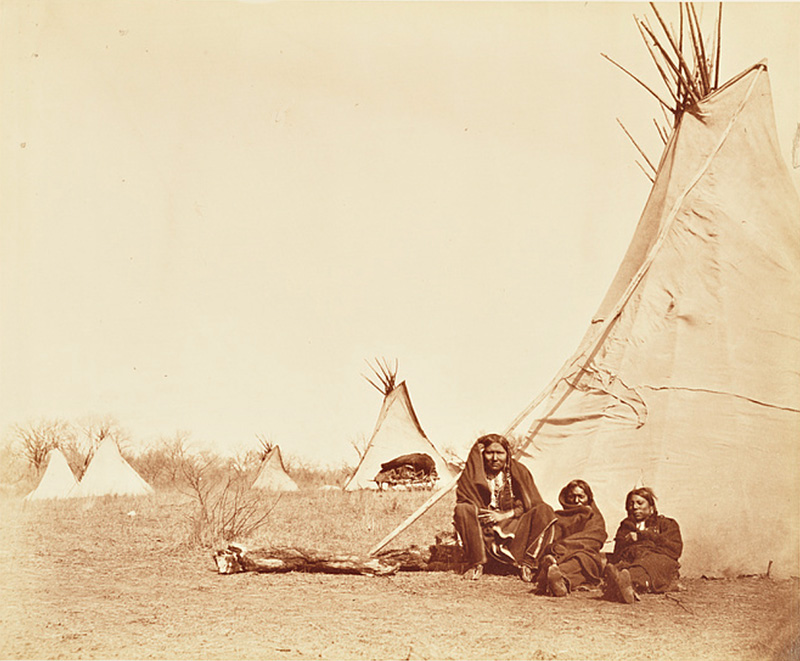 Library of Congress
Library of Congress
William Stinson, Three Comanche men, Fort Sill,
Oklahoma, c. 1873 (albumen print)
So many books, so little time.
Sometimes you can read the article version. If you have time to waste this fine holiday Sunday, don't stare dull-witted at the idiot box or flit through dopey vids on YouTube. Acquaint yourself with a certain celebrated magazine piece, written by Sam Gwynne, which appeared in Texas Monthly in 2010.
"Around midnight, the regiment was awakened by a succession of unearthly, high-pitched yells. Those were followed by shots and more yells, and suddenly the camp was alive with Comanches riding at full gallop. Exactly what the Indians were doing was soon apparent: Mingled with the screams and gunshots and general mayhem was another sound, only barely audible at first, then rising to something like rolling thunder. The men quickly realized that it was the sound of stampeding horses. Their horses. Amid shouts of 'Every man to his lariat!' six hundred panicked horses tore loose through the camp, rearing, jumping, and plunging at full speed. Lariats snapped with the sound of pistol shots; iron picket pins, which a few minutes before had been used to secure the horses, now whirled and snapped about their necks like airborne sabers. Men tried to grab them and were thrown to the ground and dragged among the horses, their hands lacerated and bleeding.
"When it was all over, the soldiers discovered that Quanah and his warriors had made off with seventy of their best horses and mules, including Colonel Mackenzie’s magnificent gray pacer. In West Texas in 1871, stealing someone’s horse was often equivalent to a death sentence. It was an old Indian tactic, especially on the High Plains, to simply take a white man’s horse and leave him to die of thirst or starvation. Comanches had used it to lethal effect against the Spanish in the early eighteenth century. In any case, an unmounted Army regular stood little chance against a mounted Comanche. This midnight raid was Quanah’s calling card, a clear message that hunting him and his Comanche warriors in their homeland was going to be a difficult and treacherous business."
The piece is "Last Days of the Comanches" and it appeared in the May issue. Justly famed. A must-read.
Sam Gwynne also wrote a book about Stonewall Jackson (excellent, although I must say the venerated General was a very odd bird indeed) and a book about football (I struggled like a lineman till time ran out but to be honest it requires more appetite for football than I possess), but his best book (in my very humble opinion) is his masterpiece about the Comanches, which was expanded from the 2010 Texas Monthly article. The book is called Empire of the Summer Moon and I've sung its praises before. Since he writes about things near and dear to the heart of Texans, I'm assuming his next books will be about barbeque and/or the Longhorns (the human kind. I think in Texas an adroit writer, which Sam Gwynne absolutely is, could roll those disparate objects of worship into one book and spare me from having to read two, because I will read anything he chooses to write, an honor I accord precious few writers).
But if you'll never have time for the book, read the article. Costs nothing. Ain't too long. Blade-sharp writing, gripping story.
Two very white fat girls in one-piece bathing suits just pedaled by on a recumbent tandem bicycle, swerving lazily to and fro. Parked cars crowd the shore and neighbors were igniting fireworks (illegally, but the police aren't enthusiastic about enforcing that law) last night after dark. It's the last big weekend of the Summer and it's fantastical to believe it's here.
Me, I'm taking the day off. Coming up: How to say "Nikon," a camera bargain, and what Sony should do.
Mike
Original contents copyright 2018 by Michael C. Johnston and/or the bylined author. All Rights Reserved. Links in this post may be to our affiliates; sales through affiliate links may benefit this site.
B&H Photo • Amazon US • Amazon UK
Amazon Germany • Amazon Canada • Adorama
(To see all the comments, click on the "Comments" link below.)
Featured Comments from:
Rob White: "Having a copy of Empire of the Summer Moon and being a huge fan of Western history, I heartily recommend and endorse the book. It's found a place in my collection of must-read, must-keep books and is a very easy read!"
Bruce: "Darn you, Michael Johnston...I wake up, log in, and am still here two hours later reading about North American history having not been remotely interested previously!
"Growing up in New Zealand, now living in Australia, we were taught little or nothing about Native American issues, apart from the awful, skewed ideas that were prevalent then...(all bad). The article from Texas Monthly is riveting reading...made me click over to Google Earth and scan the country. Fascinating indeed! I am only now, in my early 70s, starting to appreciate the incredible lives of Indigenous Australians, and their Rock Art especially. (By far the oldest in the world!) And I love listening to Maori language on fishing and hunting TV shows emanating from NZ on our SBS-TV. Aaah, to be a few years younger...so much to absorb, so much to photograph. Thanks for a fascinating, educational morning. "
Bill La Via: "Yes, I read the book a few years ago after your recommendation; never thanked you for the tip but would like to do so now. The full book is excellent and well worth the read. Thanks for the suggestion!"
scott kirkpatrick: "The Gwynne article is compelling, but his book, Empire of the Summer Moon, is unforgettable. This is the land about which [photographer] Frank Gohlke writes (in Where I Come From): 'Until the 1860s, most of the Red River Valley was too dangerous for permanent settlement. The Comanche's claim to exclusive use of North Texas derived from their willingness to kill anyone (white or native) whose presence annoyed them and to cheat or rob the rest...the Comanches were not vanquished until they encountered a people who were meaner, more ruthless, and less trustworthy than they were, the Texans. My people.'"
Speed: "At Mike's recommendation (June 2011) I read Empire of the Summer Moon which includes 'Last Days of the Comanches.' The book teaches a history of the United States that we never got in school. And if history had been taught this way I'd have studied it more. Or at all."
Joe Holmes: "I read Empire of the Summer Moon on your recommendation and found it absolutely unforgettable. What a gripping and multi-faceted story! It really changed my understanding of the place that American Indians hold in our history."




